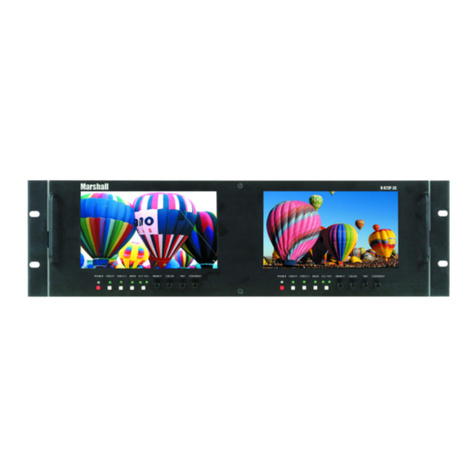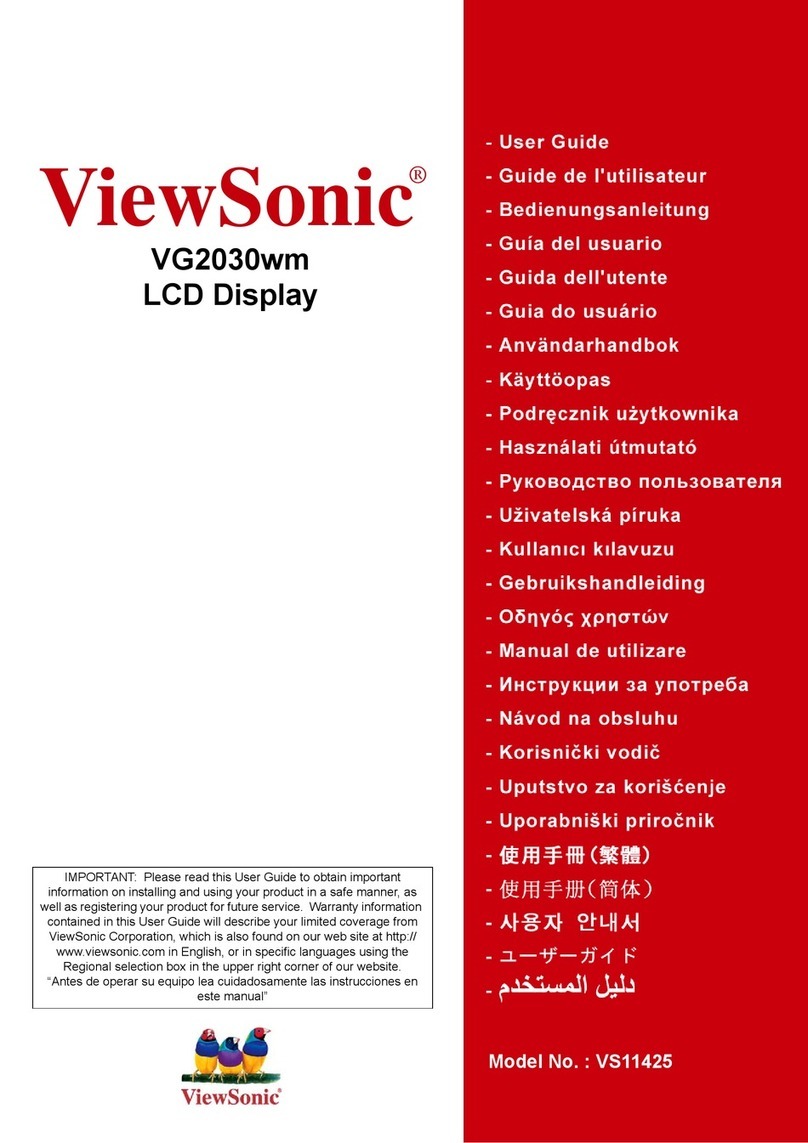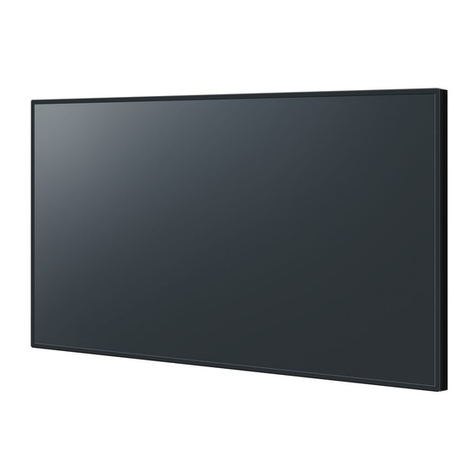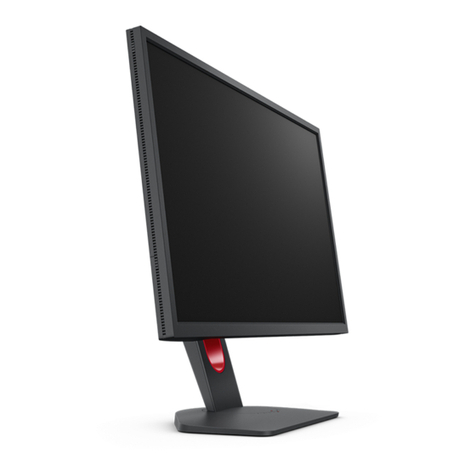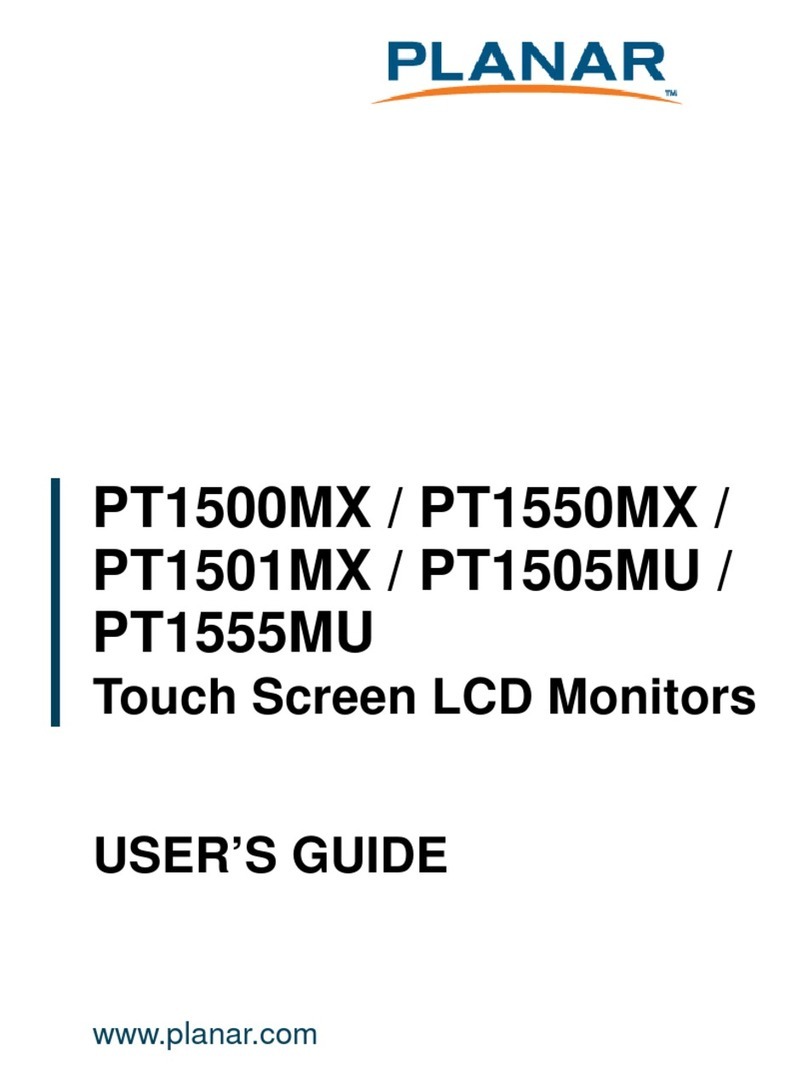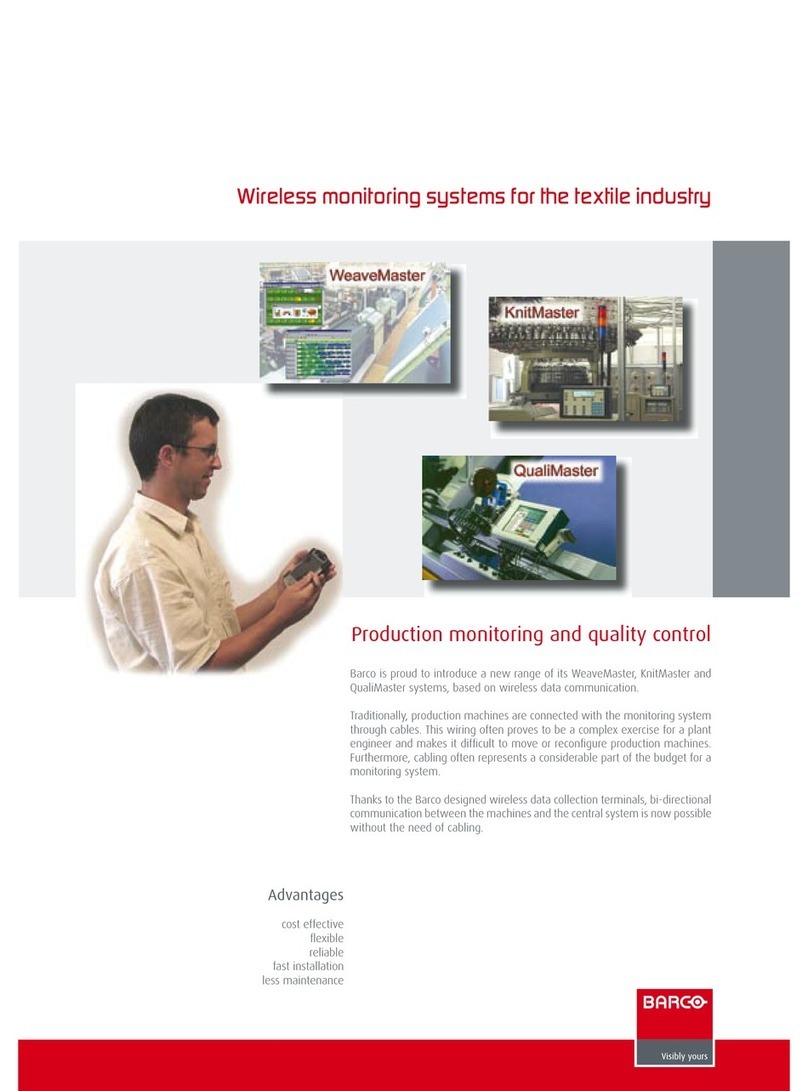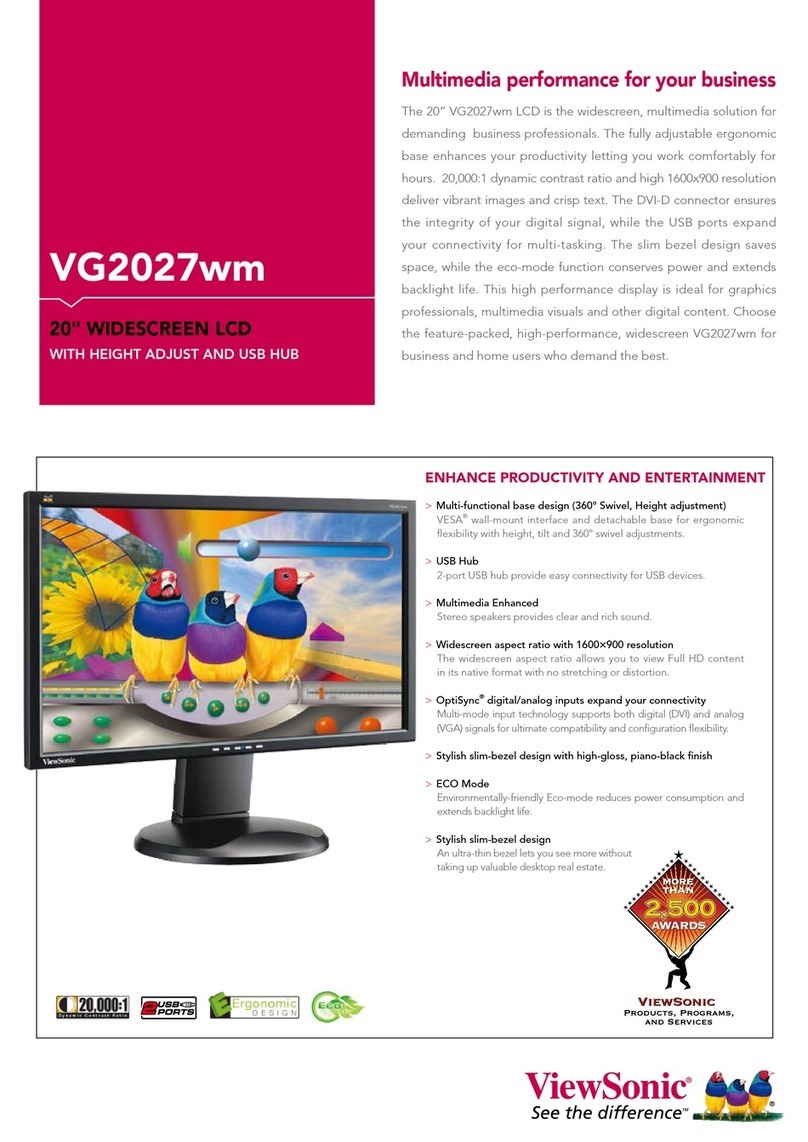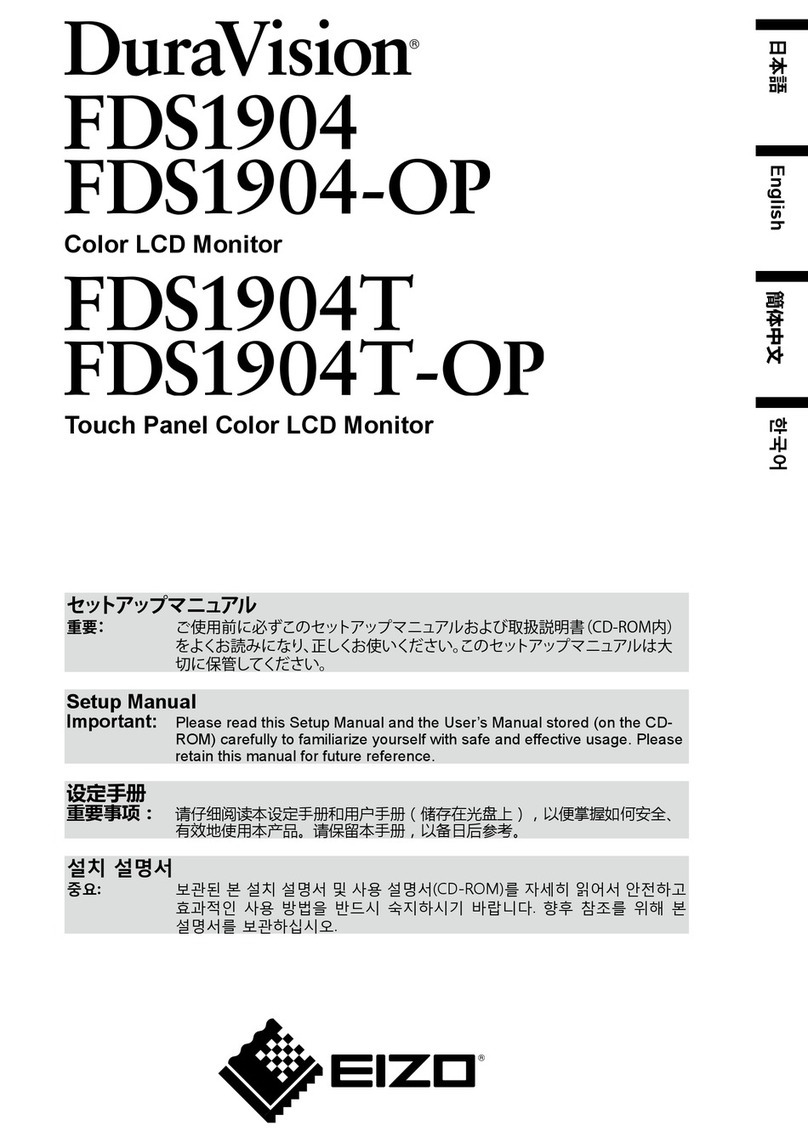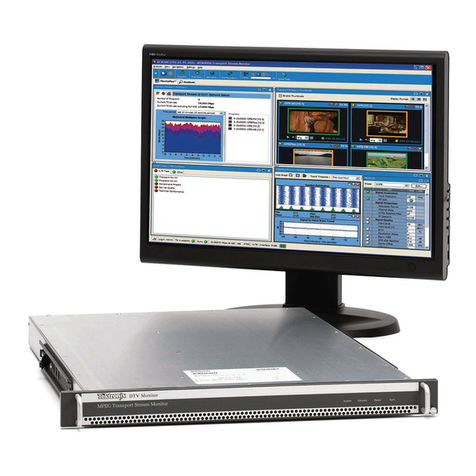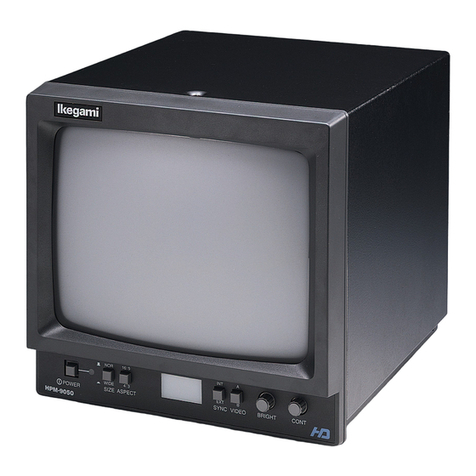Electronics International Inc MVP-50P User manual



Important Notice
***** MUST READ *****
Page 2 of 4
This manual does not make any recommendations as to specific operating parameters or controlling
methods. Check the airframe and/or engine manufacturer’s recommendations to properly operate the
aircraft systems and engine. It is the pilot’s responsibility to operate the engine and aircraft safely.
It is possible for any instrument to fail thereby displaying inaccurate high, low or jumpy readings.
Therefore, you mustmust
mustmust
must be able to recognize an instrument failure and you mustmust
mustmust
must be proficient in operating
your aircraft safely in spite of an instrument failure. If you do not have this knowledge, contact the FAA
or a knowledgeable flight instructor for training prior to flying the aircraft with this instrument.
Electronics International Inc. is not liable or responsible for a pilot’s action or any situation that results in
personal injury, property damage, missed commitments, lack of use of an aircraft or any expenses
incurred due to: product failure, inaccuracy in displayed data or text files, display or display format
issues, software bugs or problems, upgrade or customization issues, misinterpretation of the display,
warning and/or limit settings, calibration problems, installation issues (leaks, mis-wiring, obstructions,
damage to aircraft or components, incorrect installation of any parts, wrong parts, parts that don’t fit,
etc.) or any other issues related to the installation or operation of this product. All of the above are
solely the pilot’s and/or installer’s responsibility. The pilot mustmust
mustmust
must understand the operation of this prod-
uct before flying the aircraft. The pilot must not allow anyone to operate the aircraft that does not know
the operation of this product. The pilot must keep the instrument Operating Instructions in the aircraft at
all times.
Set a unique password to protect all of the calibration and setup data in the MVP-50 (MVP). If setup or
calibration data is inadvertently or improperly changed, you could get inaccurate readings that may lead
to improper operation of the aircraft or engine. This could result in engine damage and/or an emergency
situation.
Before using the Weight and Balance screen check that the “Weight and Balance Setup” data in the MVP
System Configuration Menu is accurate. Always verify the MVP weight and balance data with you
aircraft’s POH.
Before flying the aircraft verify that the instrument markings displayed on the MVP are accurate with
your POH for every function displayed on the MVP.
Verify that the horsepower displayed on the MVP is accurate with your aircraft's POH and/or engine TC
data.
The MVP allows the pilot to enter checklists, flight plans and general information through the USB port.
This data must be verified for accuracy by the pilot prior to flight.
The MVP must be calibrated to the aircraft fuel system and the MVP's accuracy must be verified before
flying the aircraft.

Important Notice
***** MUST READ *****
Page 3 of 4
Fuel Level Accuracy Limitations:
The accuracy limitations of the MVP are listed below. It is the pilot/owner’s obligation to makeIt is the pilot/owner’s obligation to make
It is the pilot/owner’s obligation to makeIt is the pilot/owner’s obligation to make
It is the pilot/owner’s obligation to make
anyone flying the aircraft aware of these limitations.anyone flying the aircraft aware of these limitations.
anyone flying the aircraft aware of these limitations.anyone flying the aircraft aware of these limitations.
anyone flying the aircraft aware of these limitations.
1. Angle of Attack -1. Angle of Attack -
1. Angle of Attack -1. Angle of Attack -
1. Angle of Attack - The MVP must be calibrated with the aircraft in a cruise angle of attack. If the
aircraft is in an angle of attack other than cruise, the MVP may display inaccurate fuel levels (depend-
ing on the mounting location and type of sensor used). If your aircraft does not sit at a cruise angle of
attack when on the ground, it may not display accurate fuel levels. Test your aircraft at differentTest your aircraft at different
Test your aircraft at differentTest your aircraft at different
Test your aircraft at different
angles of attack to determine how the MVP fuel level readings are affected.angles of attack to determine how the MVP fuel level readings are affected.
angles of attack to determine how the MVP fuel level readings are affected.angles of attack to determine how the MVP fuel level readings are affected.
angles of attack to determine how the MVP fuel level readings are affected.
2. Full Fuel Readings -Full Fuel Readings -
Full Fuel Readings -Full Fuel Readings -
Full Fuel Readings - As a tank is filled the fuel sensor may be unable to detect the fuel entering
the upper corners of the fuel tank. If this is the case with your sensor, the MVP may display fuel levels
lower than the actual fuel in the tanks when the tanks are full. When the fuel level drops to a point
where the fuel sensor starts to detect a change, the displayed fuel level should be accurate. Check theCheck the
Check theCheck the
Check the
accuracy of your system by comparing the displayed fuel levels on the MVP to the fuelaccuracy of your system by comparing the displayed fuel levels on the MVP to the fuel
accuracy of your system by comparing the displayed fuel levels on the MVP to the fuelaccuracy of your system by comparing the displayed fuel levels on the MVP to the fuel
accuracy of your system by comparing the displayed fuel levels on the MVP to the fuel
levels listed in the flight manual at each fill up.levels listed in the flight manual at each fill up.
levels listed in the flight manual at each fill up.levels listed in the flight manual at each fill up.
levels listed in the flight manual at each fill up.
3. Low Fuel Readings -3. Low Fuel Readings -
3. Low Fuel Readings -3. Low Fuel Readings -
3. Low Fuel Readings - Do not rely on the MVP to determine the fuel level in the tankDo not rely on the MVP to determine the fuel level in the tank
Do not rely on the MVP to determine the fuel level in the tankDo not rely on the MVP to determine the fuel level in the tank
Do not rely on the MVP to determine the fuel level in the tank
for an indicated tank level below 1/8for an indicated tank level below 1/8
for an indicated tank level below 1/8for an indicated tank level below 1/8
for an indicated tank level below 1/8. You should always fly the aircraft in such a manner as to
at least maintain the FAA minimum fuel requirements in the aircraft at all times. Depending on theDepending on the
Depending on theDepending on the
Depending on the
mounting location and type of fuel sensor used, the MVP may not be able to accuratelymounting location and type of fuel sensor used, the MVP may not be able to accurately
mounting location and type of fuel sensor used, the MVP may not be able to accuratelymounting location and type of fuel sensor used, the MVP may not be able to accurately
mounting location and type of fuel sensor used, the MVP may not be able to accurately
measure the last few gallons of fuel in the tanks.measure the last few gallons of fuel in the tanks.
measure the last few gallons of fuel in the tanks.measure the last few gallons of fuel in the tanks.
measure the last few gallons of fuel in the tanks.
4. Improper Calibration -4. Improper Calibration -
4. Improper Calibration -4. Improper Calibration -
4. Improper Calibration - If the MVP has not been properly calibrated it will not display accurate
fuel levels in the tanks. It is important to verify the accuracy of the MVP. Always cross check yourAlways cross check your
Always cross check yourAlways cross check your
Always cross check your
measured fuel levels in the tanks with the readings on the MVP before each flight.measured fuel levels in the tanks with the readings on the MVP before each flight.
measured fuel levels in the tanks with the readings on the MVP before each flight.measured fuel levels in the tanks with the readings on the MVP before each flight.
measured fuel levels in the tanks with the readings on the MVP before each flight.
5. Poor Connections -5. Poor Connections -
5. Poor Connections -5. Poor Connections -
5. Poor Connections - Poor connections between the wires leading from the EDC to the fuel
sensors can become intermittent with age. An intermittent connection most likely will show up as
wandering or inaccurate readings on the MVP. Always cross check your measured fuel levelsAlways cross check your measured fuel levels
Always cross check your measured fuel levelsAlways cross check your measured fuel levels
Always cross check your measured fuel levels
in the tanks with the readings on the MVP before each flight.in the tanks with the readings on the MVP before each flight.
in the tanks with the readings on the MVP before each flight.in the tanks with the readings on the MVP before each flight.
in the tanks with the readings on the MVP before each flight.
6. Defective Fuel Level Sensors -6. Defective Fuel Level Sensors -
6. Defective Fuel Level Sensors -6. Defective Fuel Level Sensors -
6. Defective Fuel Level Sensors - Fuel sensors can become intermittent or change resistance
with age. It is not uncommon to find intermittent problems even in new resistive sensors. An intermit-
tent problem with a fuel sensor most likely will show up as wandering or inaccurate readings on the
MVP. Always cross check the measured fuel levels in the tanks with the readings on theAlways cross check the measured fuel levels in the tanks with the readings on the
Always cross check the measured fuel levels in the tanks with the readings on theAlways cross check the measured fuel levels in the tanks with the readings on the
Always cross check the measured fuel levels in the tanks with the readings on the
MVP at each fill up.MVP at each fill up.
MVP at each fill up.MVP at each fill up.
MVP at each fill up.
If you ever find an inaccuracy issue or any other problem with a fuel level displayIf you ever find an inaccuracy issue or any other problem with a fuel level display
If you ever find an inaccuracy issue or any other problem with a fuel level displayIf you ever find an inaccuracy issue or any other problem with a fuel level display
If you ever find an inaccuracy issue or any other problem with a fuel level display
on the MVP, disable the fuel level display (see the “Redlines, Limits and Color Setup”on the MVP, disable the fuel level display (see the “Redlines, Limits and Color Setup”
on the MVP, disable the fuel level display (see the “Redlines, Limits and Color Setup”on the MVP, disable the fuel level display (see the “Redlines, Limits and Color Setup”
on the MVP, disable the fuel level display (see the “Redlines, Limits and Color Setup”
screen). This will alert anyone flying the aircraft to the condition of this display.screen). This will alert anyone flying the aircraft to the condition of this display.
screen). This will alert anyone flying the aircraft to the condition of this display.screen). This will alert anyone flying the aircraft to the condition of this display.
screen). This will alert anyone flying the aircraft to the condition of this display.

Important Notice
***** MUST READ *****
Page 4 of 4
Important Fuel Level Considerations:
DO NOT RELY SOLELY ON THE FUEL LEVEL DISPLAYED ON THE MVP TODO NOT RELY SOLELY ON THE FUEL LEVEL DISPLAYED ON THE MVP TO
DO NOT RELY SOLELY ON THE FUEL LEVEL DISPLAYED ON THE MVP TODO NOT RELY SOLELY ON THE FUEL LEVEL DISPLAYED ON THE MVP TO
DO NOT RELY SOLELY ON THE FUEL LEVEL DISPLAYED ON THE MVP TO
DETERMINE THE FUEL LEVELS IN THE AIRCRAFT.DETERMINE THE FUEL LEVELS IN THE AIRCRAFT.
DETERMINE THE FUEL LEVELS IN THE AIRCRAFT.DETERMINE THE FUEL LEVELS IN THE AIRCRAFT.
DETERMINE THE FUEL LEVELS IN THE AIRCRAFT. The use of the MVP does notThe use of the MVP does not
The use of the MVP does notThe use of the MVP does not
The use of the MVP does not
eliminate or reduce the necessity for the pilot to use good flight planning, preflight andeliminate or reduce the necessity for the pilot to use good flight planning, preflight and
eliminate or reduce the necessity for the pilot to use good flight planning, preflight andeliminate or reduce the necessity for the pilot to use good flight planning, preflight and
eliminate or reduce the necessity for the pilot to use good flight planning, preflight and
in-flight techniques for managing fuel.in-flight techniques for managing fuel.
in-flight techniques for managing fuel.in-flight techniques for managing fuel.
in-flight techniques for managing fuel. It is important the pilot adopt the practices listed below.
If you are not familiar with these techniques, contact the FAA to acquire proper training.
1.1.
1.1.
1. A copy of this Operating Instructions must be in the aircraft at all times.A copy of this Operating Instructions must be in the aircraft at all times.
A copy of this Operating Instructions must be in the aircraft at all times.A copy of this Operating Instructions must be in the aircraft at all times.
A copy of this Operating Instructions must be in the aircraft at all times.
2. Flight Planning -2. Flight Planning -
2. Flight Planning -2. Flight Planning -
2. Flight Planning - Always calculate the fuel requirement for each leg of a flight, including any
alternate plans for bad weather. Keep this information available in the aircraft during the flight. Keep
a chart of the published fuel flows for various flight/engine conditions in the aircraft. Keep a chart of
the measured fuel flows for various flights in the aircraft. Measured fuel flows can be considerably
different from published figures.
3. Preflight - Do not rely on the MVP to determine the fuel level in the fuel tanks. The3. Preflight - Do not rely on the MVP to determine the fuel level in the fuel tanks. The
3. Preflight - Do not rely on the MVP to determine the fuel level in the fuel tanks. The3. Preflight - Do not rely on the MVP to determine the fuel level in the fuel tanks. The
3. Preflight - Do not rely on the MVP to determine the fuel level in the fuel tanks. The
pilot must visually check/measure the fuel levels in the tanks before every takeoff.pilot must visually check/measure the fuel levels in the tanks before every takeoff.
pilot must visually check/measure the fuel levels in the tanks before every takeoff.pilot must visually check/measure the fuel levels in the tanks before every takeoff.
pilot must visually check/measure the fuel levels in the tanks before every takeoff. Cross
check the measured fuel levels with the displayed levels on the MVP. Also, cross check these levels
with the fuel requirements for the flight listed in your flight plan.
4. In Flight -4. In Flight -
4. In Flight -4. In Flight -
4. In Flight - Make the MVP part of your normal instrument scan. Crosscheck the fuel levelsCrosscheck the fuel levels
Crosscheck the fuel levelsCrosscheck the fuel levels
Crosscheck the fuel levels
displayed on the MVP with your flight plan at each leg of the flight or every 30 minutesdisplayed on the MVP with your flight plan at each leg of the flight or every 30 minutes
displayed on the MVP with your flight plan at each leg of the flight or every 30 minutesdisplayed on the MVP with your flight plan at each leg of the flight or every 30 minutes
displayed on the MVP with your flight plan at each leg of the flight or every 30 minutes
(if a leg is longer than 30 minutes). Calculate the fuel flows from the MVP displayed fuel levels and
compare them with your charts of measured and published fuel flows for the aircraft. If there is a
discrepancy, land the aircraft at the nearest airport and verify the fuel levels. Discrepancies should be
taken seriously.
5. New Pilot or Owner of the Aircraft -5. New Pilot or Owner of the Aircraft -
5. New Pilot or Owner of the Aircraft -5. New Pilot or Owner of the Aircraft -
5. New Pilot or Owner of the Aircraft - If there is a new pilot or new owner of theIf there is a new pilot or new owner of the
If there is a new pilot or new owner of theIf there is a new pilot or new owner of the
If there is a new pilot or new owner of the
aircraft, it is the previous aircraft pilot/owner’s responsibility to insure the new pilot/aircraft, it is the previous aircraft pilot/owner’s responsibility to insure the new pilot/
aircraft, it is the previous aircraft pilot/owner’s responsibility to insure the new pilot/aircraft, it is the previous aircraft pilot/owner’s responsibility to insure the new pilot/
aircraft, it is the previous aircraft pilot/owner’s responsibility to insure the new pilot/
owner has read this manual and is aware of any accuracy limitations and other importantowner has read this manual and is aware of any accuracy limitations and other important
owner has read this manual and is aware of any accuracy limitations and other importantowner has read this manual and is aware of any accuracy limitations and other important
owner has read this manual and is aware of any accuracy limitations and other important
considerations. All limitations and operating characteristics learned from operating theconsiderations. All limitations and operating characteristics learned from operating the
considerations. All limitations and operating characteristics learned from operating theconsiderations. All limitations and operating characteristics learned from operating the
considerations. All limitations and operating characteristics learned from operating the
MVP must be passed on to the new pilot/owner.MVP must be passed on to the new pilot/owner.
MVP must be passed on to the new pilot/owner.MVP must be passed on to the new pilot/owner.
MVP must be passed on to the new pilot/owner.

Contents
(Page 1 of 2)
Warranty/Agreement----------------------------------------------------------------------------------------- 1
1.0 Introduction: ---------------------------------------------------------------------------------- 3
1.1 Features ------------------------------------------------------------------------------- 5
1.2 Overview of the MVP Screens: -------------------------------------------------------- 5
1.3 System Hardware: --------------------------------------------------------------------- 6
1.4 SELECT Knob and Button Operation: ------------------------------------------------- 7
1.5 Display Dimming: ---------------------------------------------------------------------- 8
1.6 Cleaning the Screen: ------------------------------------------------------------------- 8
2.0 Main Engine Screen: -------------------------------------------------------------------------- 9
2.1 Power-up Add Fuel Message: --------------------------------------------------------- 11
2.2 Main Screen Layout: ------------------------------------------------------------------- 11
2.3 RPM and Maniflod Pressure: ---------------------------------------------------------- 12
2.4 Horizontal Strip and Digital Gauges: ---------------------------------------------------- 12
2.5 Engine Analyzer: ----------------------------------------------------------------------- 13
2.6 Supporting Instruments: ---------------------------------------------------------------- 15
2.7 System Annumciators: ----------------------------------------------------------------- 16
2.8 External Master Caution and Warning Light: ------------------------------------------- 16
2.9 Voice Alarm Control Panel (OEM and Experimental): ---------------------------------- 16
2.10 Disabling a Display (Experimental Only): ----------------------------------------------- 17
3.0 System Screen: ------------------------------------------------------------------------------- 19
3.1 Trim Indicator (OEM and Experimental): ---------------------------------------------- 21
3.2 Flap Indicator (OEM and Experimental): ---------------------------------------------- 21
3.3 Gear and Unsafe Position Indicators: -------------------------------------------------- 21
3.4 Gear Up Warnig (OEM and Experimental): -------------------------------------------- 22
3.4 Engine and System Functions: ---------------------------------------------------------- 22
3.5 Main and System Annunciators: -------------------------------------------------------- 22
4.0 Flight Data Screens: -------------------------------------------------------------------------- 23
4.1 Help Screen: -------------------------------------------------------------------------- 25
4.2 System Screen: ------------------------------------------------------------------------ 25
4.3 Add Fuel Screen: ---------------------------------------------------------------------- 25
4.4 Fuel Management Screen: ------------------------------------------------------------- 27
4.5 Timers Screen: ------------------------------------------------------------------------- 28
4.6 Clock and Hour Meters Screen: ------------------------------------------------------- 28
4.7 Weight and Balance Screen: ----------------------------------------------------------- 29
4.8 Checklist Screens: --------------------------------------------------------------------- 29
4.9 Flight Notes Screens: ------------------------------------------------------------------ 30
4.10 Gen. Info. Screens: -------------------------------------------------------------------- 31
4.11 Data Logs Screens: -------------------------------------------------------------------- 32

5.0 Setup and Control Screens: ------------------------------------------------------------------ 33
5.1 EGT/CHT Bar Graph Setup Screen: -------------------------------------------------- 35
5.2 USB and Data Recording Screen: ----------------------------------------------------- 36
5.3 Voice and Display Controls Screen: --------------------------------------------------- 38
5.4 Screens Button Setup Screen: --------------------------------------------------------- 38
5.5 System Configuration Screens Menu: -------------------------------------------------- 39
6.0 System Configuration Screens: ---------------------------------------------------------------- 41
6.1 Password Protection: ----------------------------------------------------- ------------- 43
6.2 System Configuration Screens Overview: ----------------------------------------------- 44
6.3 USB Flight Data File Manager Screen: ------------------------------------------------- 44
6.4 USB Config and Software Program Manager Screen: ---------------------------------- 45
6.5 Change Password Screen: -------------------------------------------------------------- 46
6.6 Aircraft ID, Gear Warning and TAS Setup Screen: -------------------------------------- 47
6.7 Engine Data, Hour Meter and Flight Timers Setup Screen: ------------------------------ 47
6.8 Serial Port Setup Screen: --------------------------------------------------------------- 48
6.9 EGT/CHT Bar Graph Limits and Color Setup Screen: ---------------------------------- 50
6.10 Weight & Balance Setup Screen: ------------------------------------------------------ 52
6.11 Fuel Tank Calibration Screen: ---------------------------------------------------------- 52
6.12 Horsepower Calibration Screen: ------------------------------------------------------- 53
6.13 Pressure Altitude Calibration Screen: --------------------------------------------------- 54
6.14 Flaps, Trim and Special Function Calibration Screen: ----------------------------------- 54
6.15 MVP Input/Output Tests Screen: ------------------------------------------------------ 55
6.16 EDC Inputs, Functions and Screens Setup Section: ------------------------------------- 55
6.17 1. EDC Input to Function Mapping Screen: -------------------------------------------- 56
6.18 2. Function to Main Screen Mapping Screen: ------------------------------------------ 57
6.19 3. Function to System Screen Mapping Screen: ---------------------------------------- 57
6.20 4. Redlines, Limits and Color Setup Screen: ------------------------------------------- 57
6.21 5. EDC Input Calibration Screen: ------------------------------------------------------ 58
Appendix ------------------------------------------------------------------------------------------ 61
Specifications/Features:
A1.0 Appendix: CreatingaChecklist,FlightPlanorGeneralInformationFile
A2.0 Appendix: RecordedFlightDataFormatting
A3.0 Appendix: CalibratingAirspeed
A4.0 Appendix: AddingCustomVoiceWarningFilesto the MVP
A5.0 Appendix: SettingUpthe Gear PositionandUnsafeIndicators
A6.0 Appendix: SettingUpthe GearWarning Feature
A7.0 Appendix: SettingUptheMVPtoMonitor andDisplayanAnnunciator
Contents
(Page 2 of 2)

1
Warranty / Agreement
You must read the entire Installation and Operating Instructions. If you do not agree to andYou must read the entire Installation and Operating Instructions. If you do not agree to and
You must read the entire Installation and Operating Instructions. If you do not agree to andYou must read the entire Installation and Operating Instructions. If you do not agree to and
You must read the entire Installation and Operating Instructions. If you do not agree to and
accept the terms of this warranty/agreement and the responsibilities set forth in these manuals,accept the terms of this warranty/agreement and the responsibilities set forth in these manuals,
accept the terms of this warranty/agreement and the responsibilities set forth in these manuals,accept the terms of this warranty/agreement and the responsibilities set forth in these manuals,
accept the terms of this warranty/agreement and the responsibilities set forth in these manuals,
DO NOT install this product. Contact E.I. for a refund.DO NOT install this product. Contact E.I. for a refund.
DO NOT install this product. Contact E.I. for a refund.DO NOT install this product. Contact E.I. for a refund.
DO NOT install this product. Contact E.I. for a refund.
Electronics International Inc. (EI) warrants this instrument and system components to be free from defects in
materials and workmanship for a period of one year from the purchase date. EI will repair or replace any item
under the terms of this Warranty provided the item is returned to the factory prepaid.
Electronics International Inc. is not liable or responsible for a pilot’s action or any situation that results in
personal injury, property damage, missed commitments, lack of use of an aircraft or any expenses incurred due
to: product failure, inaccuracy in displayed data or text files, display or display format issues, software bugs or
problems, upgrade or customization issues, misinterpretation of the display, warning and/or limit settings,
calibration problems, installation issues (leaks, mis-wiring, obstructions, damage to aircraft or components,
incorrect installation of any parts, wrong parts, parts that don’t fit, etc.) or any other issues related to the instal-
lation or operation of this product. All of the above are solely the pilot’s and/or installer’s responsibility. The
pilot mustmust
mustmust
must understand the operation of this product before flying the aircraft. The pilot will not allow anyone
to operate the aircraft that does not know the operation of this product. The pilot will keep the instrument
Operating Instructions in the aircraft at all times.
By installing this product, the aircraft owner/pilot and installer agree to hold Electronics International Inc.
harmless and in no way responsible for monetary compensation, including punitive damages for any incident,
harm and/or damage associated with this product (including but not limited to the ones listed above). If you do
not agree to the above, DO NOT INSTALL THIS PRODUCT.DO NOT INSTALL THIS PRODUCT.
DO NOT INSTALL THIS PRODUCT.DO NOT INSTALL THIS PRODUCT.
DO NOT INSTALL THIS PRODUCT.
This Warranty shall not apply to any product that has been repaired or altered by any person other than Elec-
tronics International Inc., or that has been subjected to misuse, accident, incorrect wiring, negligence, improper
or unprofessional assembly or improper installation by any person. This warranty does not cover anyThis warranty does not cover any
This warranty does not cover anyThis warranty does not cover any
This warranty does not cover any
reimbursement for any person’s time for installation, removal, assembly or repair.reimbursement for any person’s time for installation, removal, assembly or repair.
reimbursement for any person’s time for installation, removal, assembly or repair.reimbursement for any person’s time for installation, removal, assembly or repair.
reimbursement for any person’s time for installation, removal, assembly or repair. Electronics
International retains the right to determine the reason or cause for warranty repair and if the product will be
covered.
Personal injury or property damage due to misinterpretation or lack of understanding of this product is solely
the pilot’s responsibility. The pilot mustmust
mustmust
must understand all aspects of the operation of this product before flying
the aircraft. If he/she does not, he/she agrees to seek training from a knowledgeable instructor. Do not allow
anyone to operate the aircraft that does not know the operation of this product. Keep the Operating Instruc-
tions in the aircraft at all times.
This warranty does not extend to any machine, vehicle, boat, aircraft or any other device to which the Electron-
ics International Inc. product may be connected, attached, interconnected or used in conjunction with in any
way.
The obligation assumed by Electronics International Inc. under this warranty is limited to repair, replacement or
refund of the product, at the sole discretion of Electronics International Inc.
Electronics International Inc. is not liable for expenses incurred by the customer or installer due to factory
updates, modifications, improvements, changes, or any other alterations to the product that may affect the
form, fit, function or operation of the product.
More On Next PageMore On Next Page
More On Next PageMore On Next Page
More On Next Page

2
Electronics International is not responsible for shipping charges or damages incurred under this Warranty.
No representative is authorized to assume any other liability for Electronics International Inc. in connection
with the sale of Electronics International Inc. products.
This Warranty is made only to the original user. THIS WARRANTY IS IN LIEU OF ALL OTHERTHIS WARRANTY IS IN LIEU OF ALL OTHER
THIS WARRANTY IS IN LIEU OF ALL OTHERTHIS WARRANTY IS IN LIEU OF ALL OTHER
THIS WARRANTY IS IN LIEU OF ALL OTHER
WARRANTIES OR OBLIGATIONS: EXPRESS OR IMPLIED. MANUFACTURER EXPRESSLYWARRANTIES OR OBLIGATIONS: EXPRESS OR IMPLIED. MANUFACTURER EXPRESSLY
WARRANTIES OR OBLIGATIONS: EXPRESS OR IMPLIED. MANUFACTURER EXPRESSLYWARRANTIES OR OBLIGATIONS: EXPRESS OR IMPLIED. MANUFACTURER EXPRESSLY
WARRANTIES OR OBLIGATIONS: EXPRESS OR IMPLIED. MANUFACTURER EXPRESSLY
DISCLAIMS ALL IMPLIED WARRANTIES OF MERCHANTABILITY OR FITNESS FOR ADISCLAIMS ALL IMPLIED WARRANTIES OF MERCHANTABILITY OR FITNESS FOR A
DISCLAIMS ALL IMPLIED WARRANTIES OF MERCHANTABILITY OR FITNESS FOR ADISCLAIMS ALL IMPLIED WARRANTIES OF MERCHANTABILITY OR FITNESS FOR A
DISCLAIMS ALL IMPLIED WARRANTIES OF MERCHANTABILITY OR FITNESS FOR A
PARTICULAR PURPOSE. PURCHASER AGREES THAT IN NO EVENT SHALL MANUFAC-PARTICULAR PURPOSE. PURCHASER AGREES THAT IN NO EVENT SHALL MANUFAC-
PARTICULAR PURPOSE. PURCHASER AGREES THAT IN NO EVENT SHALL MANUFAC-PARTICULAR PURPOSE. PURCHASER AGREES THAT IN NO EVENT SHALL MANUFAC-
PARTICULAR PURPOSE. PURCHASER AGREES THAT IN NO EVENT SHALL MANUFAC-
TURER BE LIABLE FOR SPECIAL, INCIDENTAL OR CONSEQUENTIAL DAMAGES, IN-TURER BE LIABLE FOR SPECIAL, INCIDENTAL OR CONSEQUENTIAL DAMAGES, IN-
TURER BE LIABLE FOR SPECIAL, INCIDENTAL OR CONSEQUENTIAL DAMAGES, IN-TURER BE LIABLE FOR SPECIAL, INCIDENTAL OR CONSEQUENTIAL DAMAGES, IN-
TURER BE LIABLE FOR SPECIAL, INCIDENTAL OR CONSEQUENTIAL DAMAGES, IN-
CLUDING LOST PROFITS OR LOSS OF USE OR OTHER ECONOMIC LOSS. EXCEPT ASCLUDING LOST PROFITS OR LOSS OF USE OR OTHER ECONOMIC LOSS. EXCEPT AS
CLUDING LOST PROFITS OR LOSS OF USE OR OTHER ECONOMIC LOSS. EXCEPT ASCLUDING LOST PROFITS OR LOSS OF USE OR OTHER ECONOMIC LOSS. EXCEPT AS
CLUDING LOST PROFITS OR LOSS OF USE OR OTHER ECONOMIC LOSS. EXCEPT AS
EXPRESSLY PROVIDED HEREIN, MANUFACTURER DISCLAIMS ALL OTHER LIABILITYEXPRESSLY PROVIDED HEREIN, MANUFACTURER DISCLAIMS ALL OTHER LIABILITY
EXPRESSLY PROVIDED HEREIN, MANUFACTURER DISCLAIMS ALL OTHER LIABILITYEXPRESSLY PROVIDED HEREIN, MANUFACTURER DISCLAIMS ALL OTHER LIABILITY
EXPRESSLY PROVIDED HEREIN, MANUFACTURER DISCLAIMS ALL OTHER LIABILITY
TO PURCHASER OR ANY OTHER PERSON IN CONNECTION WITH THE USE OR PERFOR-TO PURCHASER OR ANY OTHER PERSON IN CONNECTION WITH THE USE OR PERFOR-
TO PURCHASER OR ANY OTHER PERSON IN CONNECTION WITH THE USE OR PERFOR-TO PURCHASER OR ANY OTHER PERSON IN CONNECTION WITH THE USE OR PERFOR-
TO PURCHASER OR ANY OTHER PERSON IN CONNECTION WITH THE USE OR PERFOR-
MANCE OF MANUFACTURER’S PRODUCTS, INCLUDING SPECIFICALLY LIABILITY INMANCE OF MANUFACTURER’S PRODUCTS, INCLUDING SPECIFICALLY LIABILITY IN
MANCE OF MANUFACTURER’S PRODUCTS, INCLUDING SPECIFICALLY LIABILITY INMANCE OF MANUFACTURER’S PRODUCTS, INCLUDING SPECIFICALLY LIABILITY IN
MANCE OF MANUFACTURER’S PRODUCTS, INCLUDING SPECIFICALLY LIABILITY IN
TORT.TORT.
TORT.TORT.
TORT.

1.01.0
1.01.0
1.0
IntroductionIntroduction
IntroductionIntroduction
Introduction
1.1 Features:
1.2 Overview of the MVP Screens:
1.3 System Hardware:
1.4 SELECT Knob and Button Operation:
1.5 Display Dimming:
1.6 Cleaning the Screen:
3

1.1 Features:
The MVP-50P is a state-of-the-art GlassPanelEngine Monitor
within-flightdatathatprovidesmostoftheengine and system
instrumentsfoundinanaircraftpanel. Eachoftheinstruments
displayedonthe MVP’s MainEngineScreenprovides featuresnot
foundinmostmultifunctionaldisplaysortraditionalgauges.
Aircraftpanelsequippedwithindividualinstrumentsrequireapilot
toscan andinterpreta multitudeofgauges spreadacrossan entire
panel. Byprovidingasinglelocationforviewingtheengineand
manyaircraftsysteminstruments,theMVPreducesapilot’s
workloadandthechance of missingaproblem. Additionally, the
MVPprovidesbothanaloganddigitaldisplayswithdigitsthatblink
andchange colors whenyellowor redoperatingranges are
reached,anexternal CautionandWarning Lightcanbeplaced in
frontofthepilot,andaVoiceWarningsystem(experimentalonly)
isprovided. All of thesefeatures aredesignedto alertthepilot the
momentanymonitoredfunctionentersared oryellow operating
range.
1.2 Overview of the MVP Screens:
MainEngineScreen (seesection2.0): The Main Engine
Screendisplaysmostoftheengineandaircraftinstruments
monitoredby theMVP. Thisis thescreen theMVPdisplaysafter
power-upandisthe screenthepilotwillview formostoftheflight.
System Screen (see section 3.0): The System Screen is
intendedtodisplay functionsthatdo notneedto bedisplayed
continuously. If any functiononthe System Screenreachesa red
oryellowoperatingrange, asystemannunciatorlocatedbetween
theRPMandM.P.displays ontheMainEngineScreen willblink.
Inthisway thepilotisalerted ofapotentialproblem andshould
viewtheSystemScreenforfurtherinformation.
FlightDataScreens (see section 4.0): The Flight Data Screen
Menuprovides accesstoscreens designedtoassist thepilot in
aircraftandengineoperation,flightmanagement,procedures,rules
andregulationsandawealthofotherinformation. AlloftheFlight
DataScreens aredisplayed againstablue backgroundand data
willbedisplayed ontheleftside oftheMVP screen. The engine
instrumentswillbedisplayedinadigitalformatontherightsideof
thescreen againsta blackbackground. Atthe topof theengine
instrumentsaretwo annunciators,oneforthe MainScreenand one
fortheSystem Screen. Ifanyfunction ontheMain orSystem
5
Main Screen
System Screen
FlightDataScreen Menu

Screengoes intoa red oryellow operatingrange, the appropriate
annunciatorwillblink,theappropriateexternalwarninglightwill
blinkandanappropriatevoice warningwillbeplayed
(experimentalonly). Inthiswaythepilotisimmediatelyalertedofa
potentialproblemand shouldviewtheappropriate screenfor
furtherinformation.
Setup and Control Screens (see section 5.0): The Setup and
ControlScreenMenu providesaccessto screenscontaining
parametersthatthepilot maywanttochangefrom timetotime
duringaflight(bargraphscaling,scanrate,recordinginterval,
controlofwarnings, brightness control,screenbuttonsetup, etc.).
SystemConfigurationScreens (see section 6.0): The System
ConfigurationScreenMenu providesalist ofsetupscreensused to
configuretheMVP for almostanyaircraft. Thesescreens areonly
accessiblebytheinstaller.
The“MVP-50PSetupChecklist”willguidetheinstallerthrough
thenecessary stepsto setup theMVP fora specificaircraft. The
“MVP-50PSetup Checklist”is providedon aseparateblue tag-
board. To make a change to data on any one of these screens
requiresthe appropriatepassword (seethe PasswordProtection
sectionofthismanual).
AlloftheSystemConfigurationScreenswillbedisplayedwitha
blackbackgroundandtheengineinstruments will notbedisplayed.
1.3 System Hardware:
6
Setupand ControlScreenMenu
Master
Warning
Light
To
Pwr&Gnd
GPS
Auto Panel
Warning
and
Caution
Lights
SystemConfiguration Screens

TheMVPhardwareconsistsof the followingthreegroupsofcomponents:
A. Probes,Transducers andExtensionCables – These components are used to measure pressures,
temperatures,fuelflow,volts,amps,fuellevelsandmany otherengine andaircraftsystemfunctions. The
analogsignals produced bythe transducersandprobes areroutedthrough theExtensionCables to
variousEDCinputs.
B. EDC(Engine DataConverter) –The EDCconverts theanalog signalsfrom theprobes and
transducersto adigitalformat. This dataistransmitted viaatwo-wire RS422cable to theMVPDisplay.
C. MVPDisplay –The MVP receives, processes and displays the RS422 EDC data on its TFT color
display. In addition, theMVPreceivesGPS data,interfaceswith theVoiceWarningControl Panel and
monitorstheexternal backlightcontrolline. Also, theMVPtransmitsfueldatato theGPSand controls
theexternalCautionandWarningLights.
TheMVP reduces thenumber ofpanel-mountedinstruments fromaround15 toonly1. The EDCcanreduce the
totalnumberof wiresroutedto theaircraftinstrument panelby100 or more.
1.4 SELECT Knob and Button Operation:
SELECTKnob: The SELECTknob canbe rotatedor pressed. Dependingon thescreen andfield being
viewed,rotating the knobcan moveanarrow,select adigit,or changeadigits value. PressingtheSELECTknob
willchoosethehighlighteditem.
EXITButton: Pressingthe EXITbuttonwillexit yououtof a specificoperation. Repeatedpresses willexityou
outofthe currentscreen,returningyou totheprevious screen viewed. You canalwaysreturnto theMainEngine
InstrumentScreen by repeatedlypressingthe EXITbutton.
SCREENSButton: Pressing theSCREENSbutton sequencestheMVP througha listofFlight DataScreens.
TheFlight DataScreens thatwillbe displayedcan bepre-selected ontheScreens ButtonSetup page. The
SCREENSbutton allowsyou quickaccessto thescreens youuse mostfrequently. To navigateto the “Screens
ButtonSetup”page startbyviewing theMainEngine Screen, pushtheMenu buttonandselect theScreensButton
Setupnear thebottom ofthe page.
MENUButton: TheMENU buttondisplaysthemenu forthecurrentscreen viewed(providingamenu isavailable
forthat screen). Some screensdonot haveamenu available. IftheMENU buttonispushed whiledisplayingthe
MainEngineScreen,the“FlightDataScreens Menu”will bedisplayed.
7

1.5 Display Dimming:
TheMVPprovidestwomethods of controllingthebrightnessoftheTFTdisplay. Whenthe“Brightness Control”is
setfor“AutoDimming,”thedisplaywill automaticallydim asthe ambientlightreduces. Thelightsensorislocated
nextto theUSB porton theMVP front panel.
Whenthe“Brightness Control”isset for “External,”anexternal controlpotcanbe usedtocontrol the brightness
ofthe MVPdisplay. TheElectronics InternationalCP-1-MVPIntensityControl Pot canbe usedforthis purpose.
Note: TheMVPdisplaywillbe atfullintensityifthe“BrightnessControl” issetto“External”andthereis no
externalpot connectedto theMVP.
TheBrightnessControl canbefound onthe“Display Controls”screen. To navigatetothe “DisplayControls”
screenstartby viewing theMainEngineScreen, pushtheMenubuttonand selectthe“DisplayControls”screens
nearthe bottomof thepage.
1.6 Cleaning the Screen:
TheMVPincorporates a flatpanelfull colorTFTdisplay,whichshould beprotectedfrom scratchs. TheTFT
displayshouldbecleanedusingonlyisopropylalcoholandasoftcleaningcloth. Individuallywrappedlens-cleaning
tissue(used tocleanglasses orplastic lenses)worksbest.
8

2.02.0
2.02.0
2.0
Main Engine ScreenMain Engine Screen
Main Engine ScreenMain Engine Screen
Main Engine Screen
2.1 Power-up Add Fuel Message:
2.2 Main Screen Layout:
2.3 RPM and Manifold Pressure:
2.4 Horizontal Strip and Digital Gauges:
2.5 Engine Analyzer:
2.5.1 “EGT/CHT”Operating Mode:
2.5.2 “Normalized”Operating Mode:
2.5.3 “Lean - ROP” Operating Mode:
2.5.4 “Lean-LOP”OperatingMode:
2.6 Supporting Instruments:
2.7 “System” Annunciator:
2.8 External Master Caution and Warning Lights:
2.9 Voice Alarm Control Panel (Experimental Only):
2.10 Disabling a Display (Experimental Only):
9

TheMainEngineScreenprovidestheaircraftsystemandengineinstrumentsyouwillviewmostfrequentlyduringa
flight. Thereisimportantinformationpublished intheImportantNoticesection(foundin thefrontofthis
manual)that mustbereadbeforeoperatingthisinstrument. Pleaseread theImportant Noticesection atthis
time.
2.1 Power-up Add Fuel Message:
TheMVPrequires approximately14 seconds topower-up. You may wantto switchon theMasterSwitch when
firstenteringthe aircrafttoinsure theMVPis poweredupwhen youareready tostartthe engine.
An“AddFuelMessage” located intheengineanalyzersection of thescreenwillappearwhen the MVPisfully
poweredup. The purposeofthis messageis toremindyou toupdate thefuelcomputer ifyou haveaddedfuel to
theaircraft. TheMVP notonlymeasuresand displaysthefuelin thefueltanksbut italsodisplaysthe fuel on-board
theaircraftcalculated fromthefuelflow. Thisallowsyou tocrosscheckfuel readingstoinsureaccuracy. The“Add
FuelMessage”can beacknowledgedby pressinganybutton.
2.2 Main Screen Layout:
TheMainEngineScreenislaidoutinfourareas:
RPM and Manifold Pressure (see section 2.3):
TheRPMandManifold Pressure instrumentsare
locatedat thetop left of the screen. Eachof these
instrumentsincorporatesalargearcanddigital
display.
HorizontalStripandDigital Gauges(see
section2.4): Aseries ofsix Horizontal Strip
Gauges(withdigitalreadouts)and fourdigital
instrumentsarelocatedon therightsideofthe
screen.
EngineAnalyzer(see section2.5): The Engine
Analyzerislocatedon thelowerleftportion of the
MainEngineScreen. TheEngineAnalyzermonitors
bothEGTs and CHTs. TheEngineAnalyzer
providesbothbar graphanddigitalformats and
incorporatesfeaturesforleaning,detecting and diagnosingengineproblems. The“SELECTknobcontrolsthe
displayandoperationof theengineanalyzerportionof thescreen.
SupportingInstruments(see section2.6): The digitalinstrumentson thebluebackground, locatedin the
middleofthedisplay,aresupportinstruments. Many oftheseinstrumentsmaybeconfiguredto display
variousfunctions.
11

2.3 RPM and Manifold Pressure:
TheRPMandM.P.instrumentsincorporateadigitalreadoutandan
analogarc. Thecolorofthedigitalreadoutwillreflectthecurrentrange
inwitchthefunctionisoperating(i.e.,iftheRPMisoperatinginthered,
thedigitalreadoutwillbered).
ThedigitaldisplaycanbesettoblinkwhentheRPMorM.P.operating
levelreachesayelloworredoperatingrange. Tostoptheblinking,
pushanybutton,orrotatetheSELECTknob. Also,acknowledgingavoicewarningusingtheexternal“Voice
AlarmControlPanel”willstoptheblinkingofanydigitaldisplay.
TheMVP’sRPMInstrumentprovidesaMagOutfeatureinadditiontothearcanddigitaldisplay. TheMVP
continuallymonitorsbothmagsignals. Ifonemagfails,anappropriate“L.MagOut”or“R.MagOut”warningwill
bedisplayedontheappropriatesideoftheRPMdigitaldisplay.
2.4 Horizontal Strip and Digital Gauges:
ThesixHorizontalStripandthree DigitalGaugesprovidethefollowingfeatures:
A. Thecolored operatingranges shown onthe HorizontalStrip canbeset upfor
anyaircraft.
B. EachHorizontalStripGaugefeatures apointer(triangle)markingthecurrent
operatinglevel. Also,the pointerallowsthe pilottointerpretrate andtrend
informationandprovidesfieldofvision.
C. Adigitaldisplayisfeaturedwith eachHorizontalStripGauge.
D. Thedigitalwillblinkwhena function’s operatinglevelreachesayelloworred
operatingrange. Tostop the blinking,push anybutton,or rotatetheSelect
knob. Also,acknowledgingavoicewarningusingtheexternal“VoiceAlarm
ControlPanel”(experimentalonly)willstoptheblinkingofanydigitaldisplay.
12
L. Mag
Out

13
2.5 Engine Analyzer:
TheEngineAnalyzerDisplay hasfiveoperatingmodes: EGT/CHT,Normalized,LeanROP,LeanLOPand
Digital. TheMVP’scurrent modeofoperationis displayedinthetop leftportionofthe EngineAnalyzerDisplay.
TheSELECT knobmaybe usedto changeoperating modes.
2.5.1 “EGT/CHT”Operating Mode: The verticalbars arearranged to showthe EGTand CHT foreach
cylinder. ThehottestEGTand CHTcylinders aredesignatedby asmallred “H”inthe bottom portionofthe
appropriatebars. Themaximum andminimumoperating rangesfortheEGT barsareshown on theleftside
oftheBarGraphdisplay. Themanimumandminimumoperating
ranges for the CHT barsare shown on the rightsideof the Bar
Graphdisplay.
Theoperating rangesforthe EGTbars maybeset tomatch your
engine’soperatingtemperatures(i.e.;ifyourfullrichlow power
EGTreadingsare around1100’F,set yourLow EGTRange for
1050’F. If your peak EGT readings are around 1500’F, set your
HighEGTRange for1525’F). Thehighand lowEGTrangesmay
beset inthe“EGT/CHTBarGraphSetup” screen. Tonavigate
tothe“EGT/CHT BarGraphSetup” screenstartby viewing the
MainEngineScreen, pushtheMenubutton andselectthe“Bar
GraphSetup” screennear thebotton ofthe page.
CertifiedAircraft(EGTs): IftheEGTfor acylinderexceeds thepilot setHighEGTRange, the barfor that
cylinderwillturnwhiteandblink. Thisfeatureprovidesthepilotwith a warningof ahigh EGT.
ExperimentalAircraft(EGTs): Anindependent EGTredlinelimitmay be setforeachcylinderin the“EGT/
CHTBar GraphLimits and ColorSetup” screen. Iftheredline limitsforall theEGT’sare setto the same
valueandtheHigh EGTRange(setinthe “EGT/CHTBarGraphSetup”screen) matches theredlinelimits,a
redline willbedrawn acrossthetop ofthebars. Otherwise, thelinewill bewhite.
Themaximumand minimumoperatingrangesfor theCHTbarsare providedontheright side oftheBar
Graphdisplay. If theCHTforacylinder exceedstheset limit, thebarfor thatcylinderwillturn redandblink.
CertifiedAircraft(CHTs): Thelimitsfor theCHTs areset atthefactory andcannot bechangedin thefield.
ExperimentalAircraft(CHTs): Anindependent CHTredlinelimit maybesetfor eachcylinderinthe
“EGT/CHTBar GraphLimitsand ColorSetup”screen. If theredlinelimits forallthe CHT’s aresetto the
samevalue, aredline willbedrawn acrossthe top ofthe bars. Otherwise,theline willbewhite.
ThecurrentDigitalDisplayModeofoperation is designatedinthetoprightportionoftheEngineAnalyzer
display. Theselections areSelect,Scan andHottest. TheDigitalDisplay Modecontrolswhat willbe
displayedinthe digital sectionatthebottom oftheBarGraph display.
SelectMode: The SelectMode allowsthe pilotto selecta cylinder(displayed witha boxaround the
cylindernumber). TheEGT andCHTforthe cylinderselectedareshown inthebottomleft portionof
thedisplay. The“DIFF”value providedbelowthe EGTandCHTreadings isthedifferencebetween

14
thehottest andcoldest EGTsand thehottest andcoldest
CHTs. Adifferentiallimitmaybesetinthe “EGT/CHTBar
GraphSetup”screen. Informationforsettingtheselimitsis
coveredinsection5.1 ofthismanual.
ScanMode: TheScan Modeautomaticallyscans throughall
ofthecylinders. As itscansthroughthe cylinders,theEGTand
CHTnumericvaluesare displayedinthebottomportion ofthe
EngineAnalyzerdisplay. The scanratecan be setinthe “EGT/
CHTBar GraphSetup” screen. To navigateto the “EGT/CHT
BarGraphSetup”screenstart byviewingtheMainEngine
Screen,push theMenu button andselect the“EGT/CHT BarGraphSetup” screennear thebotton of
thepage.
HottestMode: The HottestMode displaysthe hottest EGTand CHTin thedigital displaybelow the
bars.
2.5.2 “Normalized”Operating Mode: The NormalizedMode of
operationisanenginediagnostic tool thatallowscomparisonofthe
currentEGTs and CHTstoa reference(pastflight). Bynormalizing
theEGTs andCHTsthe verticalbarsare broughtto thesamelevel,
creatingareferencebaseline.
TheEGTand CHTbarsmaybe normalized(leveled)at any timeby
pushingandholding the SelectKnobforfour secondsorbyentering
the“EGT/CHTBar GraphSetup”screen.
Theoffsetdatato level thebars is storedin MVPpermanent memory.
TheNormalizedMode allowschangesthat haveoccurredin theengineto bespottedeasily. Thismakesit
possibleto detecttrendsover severalflights, days,weeks,and evenyears.
2.5.3 “Lean- ROP” OperatingMode: This operating mode was
designedtoassistthepilot in leaningtheengineRich-of-PeakEGT.
Asyoulean,the EGTbarsforallcylinders willrise. Whenthefirst
cylinderreaches peakEGTa tattletalemarker will appearat thetopof
thatcylinder’sbar. The current EGTreading, PeakEGTreadingand
theTempBelow Peakreadingfor thefirstcylinder to peakwillbe
displayedatthebottomofthe EngineAnalyzerDisplay. Another
cylindermaybe selected (anditsdatadisplayed) atanytimeduring the
leaningprocess.
Oncethefirst cylinderreachespeakEGT,richenthe mixture. The
dataatthe bottom(andtop) ofthedisplaywill indicatethenumber of
degreesatwhich your engineisoperatingrich ofpeak. Thisisexactlythe informationneededtoproperly
operate ROP.

15
2.5.4 “Lean-LOP”OperatingMode: Thisoperatingmode wasdesigned toassist thepilot in leaningthe
engineLean-of-PeakEGT. As youlean,theEGTbarsforall cylinderswillrise. When thefirstcylinder
reachespeak EGTa tattletalemarker willappear atthetop ofthat cylinder’s bar.
Asyou continuetolean, additionaltattletale markers willbe placedatthe topof theappropriatebar aseach
cylinderreachespeak EGT. Thisgives a quickvisualreference astowhich cylindershavereachedpeak EGT
andat whattemperature eachcylinder peaked. Ifa falsepeak is detected (an EGT dips andthen starts
increasingagain),theMVP willresetthetattletalemarker forthatcylinderandonce again lookforthetrue
peak.
Afterthelast cylinderreachespeak EGT,thedata providedinthe top rightportionof thedisplaywill show the
“First”and “Last” cylindertoreach peakEGTandthe currenttemperaturebelow peakforeach cylinder.
Thisisexactly theinformationneededto properlyoperatedLOP.
2.5.5 “Digital”Operating Mode: The Digital Operating Mode
providesapictorialrepresentationof the engine,whichalso
providesthe digital EGTand CHTdata foreachcylinder. The
currentDigitalDisplayModeisdesignated in thetoprightportionof
theEngineAnalyzerdisplay: ActualorDiff. TheDigitalDisplay
Modecontrolsallof theBarGraph’sdigital displays.
Actual: TheActualMode indicatesthecurrent EGTand
CHTfor eachcylinder. The“H” shownnext tooneof the
EGTand CHTreadingsindicates the hottestcylinder. The
dataat the bottomof thedisplayprovides thedifference(or
spread)between thehottest and coldest EGTs andCHTs.
Diff: Inthis Mode, thecoldest cylinder isindicated bythedesignation “REF.” Eachofthe other
cylinderswilldisplaythedifferencebetween itstemperatureandthetemperatureofthe“REF”cylinder.
Thehottestcylinder willbeindicated by an“H”next totheappropriatedigital display. Thedata atthe
bottomofthe displayprovidesthe current EGTand CHTforthe “REF”(coldest)cylinder.
2.6 Supporting Instruments:
Thedigitalinstrumentsonthebluebackground,locatedinthemiddle
ofthedisplay ontheMain screen,aresupport instruments. The four
verticalinstrumentsmaybeconfiguredtodisplayvariousfunctionsin
adigitalformat orasanannunciator,suchas Canopy,Baggage
Door, Landing Lights,RotatingBeacon,etc.
TheTimers/Clocksdisplayedunder theM.P.instrumentmaybe
selectedfromfivefunctionsfoundonthe“Timers”screen. To
navigatetothe“Timers”screenstartbyviewingthe“MainEngine
Screen,”pushthe Menubuttonandselect the“Timer”screennear
thetop of themenu.
Other manuals for MVP-50P
1
Table of contents
Other Electronics International Inc Monitor manuals

Electronics International Inc
Electronics International Inc CGR-30P Owner's manual

Electronics International Inc
Electronics International Inc MVP-50T User manual

Electronics International Inc
Electronics International Inc MVP-50P User manual

Electronics International Inc
Electronics International Inc MVP-50T User manual

Electronics International Inc
Electronics International Inc CGR-30C User manual

Electronics International Inc
Electronics International Inc MVP-50T User manual
